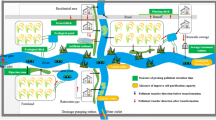Abstract
In the past three decades, the fast development of economy and urbanization has caused increasingly severe pollutions of urban water bodies in China. Consequently, eutrophication and deterioration of aquatic ecosystem, which is especially significant for aquatic vegetation, inevitably became a pervasive problem across the Yangtze River Basin. To rehabilitate the degraded urban water bodies, vegetation replanting is an important issue to improve water quality and to rehabilitate ecosystem. As a case study, a representative polluted urban river, Nanfeihe River, in Hefei City, Anhui Province, was chosen to be a rehabilitation target. In October 2009 and May 2010, 13 species of indigenous and prevalent macrophytes, including seven species emergent, one species floating leaved, and five species submersed macrophytes, were planted along the bank slopes and in the river. Through 1.5 years’ replanting practice, the water quality and biodiversity of the river had been improved. The concentrations of total nitrogen (TN), total phosphorus (TP), and ammonia nitrogen (NH4 +–N) declined by 46.0, 39.5, and 60.4 %, respectively. The species of macrophytes increased from 14 to 60, and the biodiversity of phytoplankton rose significantly in the river (p < 0.05). The biomasses of zooplankton and benthos were also improved after the vegetation replanting. The study confirmed that vegetation replanting could alleviate the increasing water pollution and rehabilitate the degraded aquatic ecosystem. The case study would be an example for polluted urban waters restoration in the middle–downstream area of Yangtze River Base.






Similar content being viewed by others
References
Brouwer E, Bobbink R, Roelofs JGM (2002) Restoration of aquatic macrophyte vegetation in acidified and eutrophied softwater lakes: an overview. Aquat Bot 73:405–431
China Environmental Protection Administration (2002) Standard methods for water and wastewater monitoring and analysis, 4th edn. China Environmental Science Press, Beijing, in Chinese
Coops H, Van den Nes EH, Van den Berg MS, Butijn GD (2002) Promoting low canopy macrophytes to compromise conservation and recreational navigation in a shallow lake. Aquat Ecol 36:483–492
Dai Y, Jia C, Liang W, Hu S, Wu Z (2012) Effects of the submerged macrophyte Ceratophyllum demersum L. on restoration of a eutrophic water body and its optimal coverage. Ecol Eng 40:113–116
Henry CP, Amoros C, Giuliani Y (1995) Restoration ecology of riverine wetlands: II. An example in a former channel of the Rhoˆne River. Environ Manag 19:903–913
Henry CP, Amoros C, Roset N (2002) Restoration ecology of riverine wetlands: A 5-year post-operation survey on the Rhône River, France. Ecol Eng 18:543–554
Hu W, Zhai S, Zhu Z, Han H (2008) Impacts of the Yangtze river water transfer on the restoration of lake Taihu. Ecol Eng 34:30–49
Janauer GA (2006) Ecohydrological control of macrophytes in floodplain lakes. Ecohydrol Hydrobiol 6:19–24
Jensen K, Trepel M, Merritt D, Rosenthal G (2006) Restoration ecology of river valleys. Basic Appl Ecol 7:383–387
Liu WG, Wu Y (2006) The Yangtze River has been suffering from “early cancer”: pollution control in need. http://www.xinhuanet.com/chinanews/2006-03/01/content_6349953.htm. Accessed 12 March 2006
Lu J, Wang H, Pan M, Xia J, Xing W, Liu G (2012) Using sediment seed banks and historical vegetation change data to develop restoration criteria for a eutrophic lake in China. Ecol Eng 39:95–103
Luderitz V, Speierl T, Langheinrich U, Volkl W, Gersberg M (2011) Restoration of the upper main and rodach rivers -the success and its measurement. Ecol Eng 37:2044–2055
Mauchamp A, Chauvelon P, Grillas P (2002) Restoration of floodplain wetlands: opening polders along a coastal river in Mediterranean France, Vistre marshes. Ecol Eng 18:619–632
Ni L (2001) Stress of fertile sediment on the growth of submersed macrophytes in eutrophic waters. ACTA Hydrobiologica Sinica 25(4):400–405
Pedersen ML, Friberg N, Skriver J, Baattrup-Pedersen A, Larsen SE (2007) Restoration of Skjern river and its valley-short-term effects on river habitats, macrophytes and macroinvertebrates. Ecol Eng 30:145–156
Peng YH, Jian YX, Wang JB, Ni LY (2004) A comparative study on aquatic plant diversity in five largest lakes of Hubei province in China. ACTA Hydrobiologica Sinica 28(5):464–470 (in Chinese)
Rosenthal G (2006) Restoration of wet grasslands—effects of seed dispersal, persistence and abundance on plant species recruitment. Basic and Appl Eco 7:409–421
Wang SM, Dou HS (1998) Record of Chinese Lakes. Science Press, Beijing, in Chinese
Wang ZY, Lee JHW, Cheng D, Duan X (2008) Benthic invertebrates investigation in the East River and habitat restoration strategies. J Hydro-Environ Res 2:19–27
Wong CM, Williams CE, Pittock J, Collier U, Schelle P (2007) World’s top 10 rivers at risk. Gland, Switzerland: WWF International. http://www.panda.org/about_wwf/what_we_do/freshwater/publications/index.cfm?uNewsID=97680
Van-Zuidam JP, Raaphorst EP, Peeters ETHM (2012) The roles of propagule banks from drainage ditches dominated by free-floating or submerged plants in vegetation restoration. Restor Ecol 20(3):416–425
Zhang J (1995) Geochemistry of trace metals from Chinese river/estuary systems: an overview. Estuar Coast Shelf Sci 41:631–658
Acknowledgments
This study was supported by the projects of National Major Program of Science and Technology (2008ZX07316-004 and 2011ZX07303-002) and National Natural Science Foundation (51108334). The authors are also grateful to Ms. Wang Yanyan and Ye Yanting for their plankton taxonomic identification.
Author information
Authors and Affiliations
Corresponding author
Additional information
Responsible editor: Hailong Wang
Rights and permissions
About this article
Cite this article
Wu, J., Cheng, S., Li, Z. et al. Case study on rehabilitation of a polluted urban water body in Yangtze River Basin. Environ Sci Pollut Res 20, 7038–7045 (2013). https://doi.org/10.1007/s11356-012-1351-9
Received:
Accepted:
Published:
Issue Date:
DOI: https://doi.org/10.1007/s11356-012-1351-9




